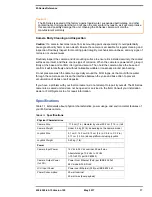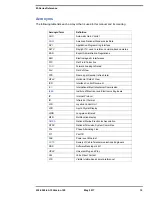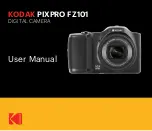
Installing M-Series Camera Systems
432-0003-60-12 Version 100
May 2017
7
Installation Planning
A number of factors must be considered when planning the installation of the M-Series camera
and JCU. It is good practice to test the unit at the planned installation location with typical vessel
electronics active prior to mounting the camera.
General Location Considerations
Determine a good location for mounting the M-Series camera unit and the JCU. The camera
requires at least three connections:
• One for power
• One network connection to the JCU or a PC
• One or two connections for the analog video
Optionally, more than one JCU can be used to control the camera and more than one display can
be used to view the video. Also a single JCU can be used to control more than one camera. The
JCU and the video monitor are mounted close together, as a pair, so the video can be viewed
when the camera position (pan or tilt) is changed with the JCU.
Consider the following points when determining the camera location:
• Mount the IP56-rated M-Series camera body as high as practical, without interfering with radar,
navigational, or communications electronics.
• Minimize the degree to which vessel structures block the camera’s 360° view.
• Mount the camera as close to the vessel’s center line as possible so you will have a
symmetrical view of on-coming traffic, obstacles, and other navigational hazards.
• The M-Series camera has a “forward” direction adjustment which has been set at
the factory. This is the direction directly toward the front of the vessel. Icons on
the video show the direction the camera is facing in relation to an outline of a
ship. After installation, the forward direction of the camera may be verified and
adjusted if required. Refer to
M-Series Operator’s Manual
(FLIR Doc. # 432-
0003-60-10).
• A camera mount suited for the camera mass and potential vibration and mechanical shock is
important for proper camera functioning. The camera is tested to hold position for mechanical
shock up to 9 g transverse and 15 g vertical. Improper mounts that are loose and/or resonate
can magnify vessel impacts causing the camera to be unable to maintain pointing direction.
• A final location consideration is the camera’s relation to other navigation devices. If you are
relying on a magnetic compass for navigation and direction, you should establish a “compass
safe distance” for any object placed in its vicinity, especially any electronic equipment. The
magnetic compass safe distance for the camera is 20 cm (7.9 in).
• Ensure the camera is installed in a location that will allow it to be accessed for regular periodic
cleaning (fresh water rinse), inspection of mounting point integrity and mechanical soundness,
and preventative maintenance.
Содержание M-Series
Страница 1: ...Installation Guide M Series ...








































